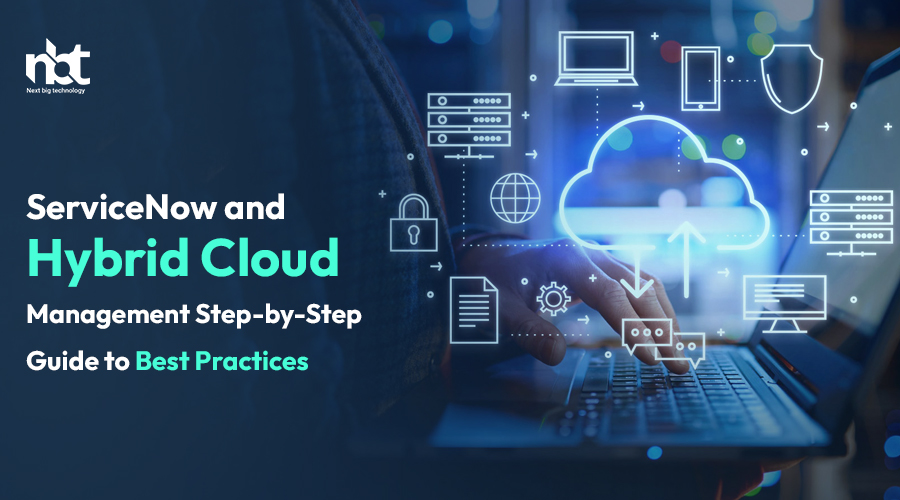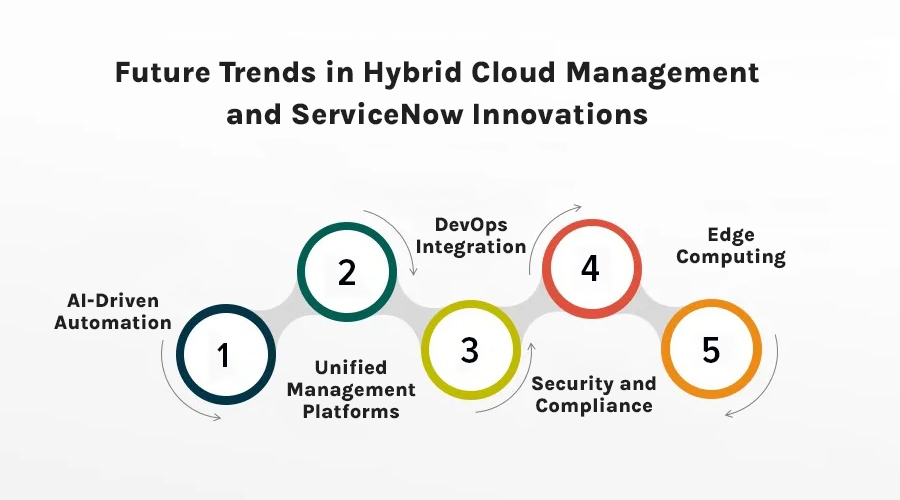Table of Contents
Introduction to ServiceNow and Hybrid Cloud Management
In the ever-evolving landscape of IT services, the integration of cloud solutions has become a cornerstone for modern enterprises. ServiceNow, a leading cloud-based platform, has emerged as a pivotal player in managing IT operations and services. Coupled with hybrid cloud management, ServiceNow offers a robust solution for businesses aiming to optimize their IT infrastructure, enhance service delivery, and streamline operations. This article delves into the essentials of ServiceNow and hybrid cloud management, exploring their benefits, functionalities, and the synergy between them.
Understanding ServiceNow
ServiceNow is a comprehensive cloud-based platform designed to automate and streamline IT service management (ITSM). It provides a suite of applications that facilitate various IT operations, including incident management, problem resolution, change management, and asset tracking. The platform is highly scalable and can be customized to meet the specific needs of any organization.
Key Features of ServiceNow:
- IT Service Management (ITSM): Centralized management of IT services, enabling efficient handling of incidents, problems, and changes.
- IT Operations Management (ITOM): Tools to manage and optimize IT infrastructure, ensuring high performance and availability.
- IT Business Management (ITBM): Solutions to align IT operations with business goals, improve decision-making, and manage portfolios.
- Security Operations: Advanced tools for identifying and mitigating security threats, ensuring compliance, and protecting data integrity.
- HR Service Delivery: Enhancing employee experience through automated HR processes and workflows.
What is Hybrid Cloud Management?
Hybrid cloud management refers to the orchestration of resources, services, and applications across multiple cloud environments, including private and public clouds. This approach allows organizations to leverage the benefits of both worlds – the control and security of private clouds and the scalability and cost-effectiveness of public clouds.
Advantages of Hybrid Cloud Management:
- Flexibility: Seamlessly deploy and manage workloads across different cloud environments based on requirements.
- Cost Efficiency: Optimize costs by balancing resource usage between private and public clouds.
- Scalability: Easily scale operations without the limitations of on-premise infrastructure.
- Risk Management: Enhance data security and compliance by distributing sensitive workloads appropriately.
The Synergy Between ServiceNow and Hybrid Cloud Management
The integration of ServiceNow with hybrid cloud management platforms creates a powerful combination that enhances IT service delivery and operational efficiency. Here’s how they complement each other:
Unified Service Management: ServiceNow provides a single pane of glass for managing IT services, while hybrid cloud management ensures that resources are optimized across various environments. Together, they offer a unified approach to service delivery, reducing complexity and improving visibility.
Automated Workflows: ServiceNow’s automation capabilities can be extended to hybrid cloud environments, enabling automated provisioning, configuration, and management of cloud resources. This reduces manual intervention, minimizes errors, and accelerates service delivery.
Enhanced Security and Compliance: By integrating ServiceNow’s security operations with hybrid cloud management, organizations can achieve better threat detection, response, and compliance management. This holistic approach ensures that security policies are consistently enforced across all environments.
Optimized Resource Utilization: With hybrid cloud management, resources can be dynamically allocated based on real-time demand. ServiceNow’s analytics and reporting tools provide insights into resource utilization, helping organizations make data-driven decisions to optimize their IT infrastructure.
Understanding Hybrid Cloud Environments
In the evolving landscape of digital transformation, hybrid cloud environments have emerged as a critical strategy for organizations seeking flexibility, scalability, and cost efficiency in their IT infrastructure. This comprehensive guide delves into the essentials of hybrid cloud environments, exploring their benefits, challenges, and best practices for implementation.
What is a Hybrid Cloud Environment?
A hybrid cloud environment combines on-premises infrastructure (private cloud) with public cloud services, allowing data and applications to be shared between them. This setup enables businesses to leverage the advantages of both cloud types, balancing the control and security of a private cloud with the scalability and cost-effectiveness of public cloud solutions.
Benefits of Hybrid Cloud Environments
- Flexibility and Scalability: Hybrid clouds offer unparalleled flexibility. Businesses can scale resources up or down based on demand, ensuring they only pay for what they use. This is particularly beneficial during peak times or unexpected spikes in workload.
- Cost Efficiency: By utilizing public cloud services for non-sensitive workloads, organizations can reduce costs associated with maintaining and scaling on-premises infrastructure. Hybrid environments also enable cost optimization through workload placement based on economic considerations.
- Enhanced Security and Compliance: Sensitive data can be kept on private clouds to comply with regulatory requirements, while less sensitive data can be stored on public clouds. This dual approach ensures that compliance and security standards are met without sacrificing efficiency.
- Business Continuity and Disaster Recovery: Hybrid clouds enhance business continuity strategies by offering robust disaster recovery solutions. Data can be backed up and replicated across multiple locations, minimizing the risk of data loss.
- Innovation and Agility: By integrating public clouds, organizations can access advanced technologies like AI, machine learning, and big data analytics. This fosters innovation and allows businesses to respond quickly to market changes.
Challenges of Hybrid Cloud Environments
- Complex Management: Managing a hybrid cloud environment can be complex due to the integration of multiple platforms and services. Ensuring seamless operation requires robust management tools and skilled IT personnel.
- Security Concerns: While hybrid clouds can enhance security, they also introduce potential vulnerabilities. Ensuring secure data transfer between private and public clouds and protecting against cyber threats requires comprehensive security measures.
- Cost Management: Although hybrid clouds can be cost-effective, they can also lead to unexpected expenses if not managed properly. Monitoring and optimizing cloud usage is essential to prevent cost overruns.
- Data Integration and Interoperability: Ensuring that data and applications work seamlessly across different cloud environments can be challenging. Interoperability issues can lead to inefficiencies and hinder performance.
Best Practices for Implementing Hybrid Cloud Environments
- Assess Business Needs: Start by evaluating your organization’s specific needs and workloads. Identify which applications and data are best suited for public or private clouds.
- Choose the Right Providers: Select cloud service providers that offer seamless integration with your existing infrastructure. Consider factors like security, compliance, and support.
- Implement Strong Security Measures: Develop a comprehensive security strategy that includes encryption, access controls, and regular audits. Ensure secure data transfer between cloud environments.
- Invest in Management Tools: Utilize advanced management tools that offer visibility and control over your entire hybrid cloud environment. These tools can help monitor performance, optimize costs, and ensure compliance.
- Develop a Clear Governance Framework: Establish clear policies and procedures for managing and using hybrid cloud resources. This includes defining roles, responsibilities, and protocols for data management and security.
- Plan for Scalability: Design your hybrid cloud architecture with scalability in mind. Ensure that it can accommodate future growth and changes in workload requirements.
Key Benefits of Using ServiceNow for Hybrid Cloud Management
In today’s dynamic business environment, organizations are increasingly adopting hybrid cloud strategies to optimize their IT infrastructure. Hybrid cloud management involves a combination of on-premises, private cloud, and public cloud services with orchestration between these platforms. Managing such a diverse ecosystem can be complex, but ServiceNow offers a robust solution to streamline and enhance hybrid cloud management. In this article, we will explore the key benefits of using ServiceNow for managing hybrid cloud environments.
1. Unified Management Platform: ServiceNow provides a unified management platform that integrates seamlessly with various cloud services. This integration allows organizations to manage their entire IT infrastructure, including on-premises and cloud resources, from a single pane of glass. With ServiceNow, IT teams can monitor, manage, and optimize their hybrid cloud environments without switching between different tools, enhancing efficiency and reducing the risk of errors.
2. Enhanced Automation and Orchestration: One of the significant advantages of using ServiceNow is its powerful automation and orchestration capabilities. ServiceNow enables IT departments to automate repetitive tasks, such as provisioning, configuration management, and incident response. This automation not only speeds up processes but also ensures consistency and compliance across the hybrid cloud environment. Moreover, ServiceNow’s orchestration engine can coordinate complex workflows involving multiple systems and cloud services, providing a streamlined approach to managing hybrid clouds.
3. Improved Visibility and Control: ServiceNow offers comprehensive visibility into the entire hybrid cloud infrastructure. Through its intuitive dashboards and reporting features, organizations can gain real-time insights into the performance, health, and utilization of their cloud resources. This improved visibility helps in proactive monitoring and troubleshooting, reducing downtime and improving service reliability. Additionally, ServiceNow provides robust control mechanisms, enabling IT teams to enforce policies, manage access, and ensure security across all cloud platforms.
4. Cost Management and Optimization: Managing costs in a hybrid cloud environment can be challenging due to the complexity of multiple billing models and usage patterns. ServiceNow’s cost management tools help organizations track and analyze their cloud spending, identify cost-saving opportunities, and optimize resource allocation. By providing detailed cost reports and forecasts, ServiceNow enables businesses to make informed decisions about their cloud investments and avoid unnecessary expenses.
5. Enhanced Security and Compliance: Security and compliance are critical considerations in hybrid cloud management. ServiceNow offers robust security features, including identity and access management, encryption, and threat detection. These features help protect sensitive data and ensure compliance with industry regulations and standards. Additionally, ServiceNow’s audit and compliance capabilities allow organizations to track and document their security measures, facilitating easier compliance reporting and reducing the risk of non-compliance.
6. Seamless Integration and Extensibility: ServiceNow’s open architecture and extensive API support enable seamless integration with a wide range of third-party tools and cloud services. This flexibility allows organizations to extend their hybrid cloud management capabilities by integrating with existing systems and adopting new technologies as needed. ServiceNow’s integration capabilities ensure that organizations can leverage their current investments while continuously evolving their IT infrastructure to meet changing business requirements.
7. Enhanced User Experience: ServiceNow is designed with a user-friendly interface that simplifies the complexities of hybrid cloud management. The platform’s intuitive design and self-service capabilities empower users to manage their cloud resources efficiently, reducing the dependency on IT support. With ServiceNow, users can quickly access the tools and information they need, leading to improved productivity and satisfaction.
Setting Up ServiceNow for Hybrid Cloud Integration
In today’s fast-paced digital environment, businesses are increasingly turning to hybrid cloud solutions to maximize their operational efficiency and flexibility. Integrating a hybrid cloud with ServiceNow, a leading IT service management (ITSM) platform, can streamline processes, enhance visibility, and improve service delivery. This article provides a step-by-step guide on setting up ServiceNow for hybrid cloud integration, ensuring you can harness the full potential of both platforms.
Understanding Hybrid Cloud Integration
A hybrid cloud combines on-premises infrastructure with public and private cloud services, offering a balance between scalability, cost efficiency, and control. The key to successful hybrid cloud integration lies in seamless connectivity, unified management, and robust security.
Why Integrate ServiceNow with Hybrid Cloud?
ServiceNow’s powerful workflow automation, IT operations management (ITOM), and service management capabilities make it an ideal candidate for managing hybrid cloud environments. Integrating ServiceNow with your hybrid cloud infrastructure can help you achieve:
- Improved Visibility: Centralized dashboards provide real-time insights across your entire IT landscape.
- Enhanced Automation: Automate routine tasks, incident management, and service requests.
- Optimized Resource Management: Efficiently allocate and manage resources across different environments.
- Strengthened Security: Implement consistent security policies and compliance measures.
Steps to Set Up ServiceNow for Hybrid Cloud Integration
1. Define Your Integration Objectives: Before diving into the technical aspects, clearly outline your integration goals. Identify the key processes you want to streamline, the specific cloud services involved, and the desired outcomes. This strategic planning will guide the implementation process and ensure alignment with business objectives.
2. Assess Your Current IT Infrastructure: Conduct a thorough assessment of your existing IT infrastructure, including on-premises systems and cloud services. This will help you identify integration points, potential challenges, and necessary upgrades. Documenting your current setup is crucial for a smooth transition to a hybrid cloud environment.
3. Choose the Right Integration Tools: ServiceNow offers various integration tools and APIs to facilitate hybrid cloud integration. Key tools include:
- ServiceNow IntegrationHub: Provides pre-built connectors for popular cloud services like AWS, Azure, and Google Cloud.
- Orchestration: Automates complex processes across different systems and services.
- APIs: Enable custom integrations tailored to your specific requirements.
4. Configure ServiceNow for Cloud Management: To manage hybrid cloud environments effectively, configure ServiceNow modules that align with your integration objectives:
- IT Operations Management (ITOM): Use ITOM to monitor and manage your entire IT infrastructure, including cloud services.
- Service Catalog: Create a catalog of cloud services that users can request, automating provisioning and de-provisioning processes.
- CMDB (Configuration Management Database): Ensure your CMDB is up-to-date with all cloud resources, providing a single source of truth for asset management.
5. Establish Connectivity and Data Flow: Set up secure connectivity between ServiceNow and your cloud environments. Utilize APIs, web services, and middleware solutions to enable seamless data exchange. Ensure that data flows bi-directionally to maintain synchronization between ServiceNow and your cloud platforms.
6. Implement Automation and Orchestration: Leverage ServiceNow’s automation capabilities to streamline routine tasks and workflows. Implement orchestration for complex, multi-step processes that span across different systems. This can include automating cloud resource provisioning, incident response, and compliance checks.
7. Monitor and Optimize Performance: Continuous monitoring is crucial for maintaining the performance and reliability of your hybrid cloud environment. Use ServiceNow’s monitoring tools to track key metrics, identify bottlenecks, and optimize resource utilization. Regularly review and refine your integration setup to adapt to evolving business needs.
8. Ensure Security and Compliance: Implement robust security measures to protect your hybrid cloud infrastructure. Use ServiceNow’s security operations (SecOps) capabilities to detect and respond to threats. Ensure compliance with industry standards and regulations by enforcing consistent security policies across all environments.
Automating Workflows in Hybrid Cloud with ServiceNow
In today’s dynamic digital landscape, businesses are increasingly adopting hybrid cloud environments to leverage the benefits of both private and public cloud platforms. As these environments grow more complex, the need for efficient workflow automation becomes paramount. ServiceNow, a leading cloud-based platform, offers robust solutions for automating workflows in hybrid cloud environments. This article explores how ServiceNow facilitates workflow automation in hybrid cloud setups, driving efficiency, cost savings, and innovation.
Understanding Hybrid Cloud Environments
A hybrid cloud environment combines private and public clouds, allowing data and applications to be shared between them. This model offers the flexibility to move workloads between cloud solutions as needs and costs fluctuate, providing businesses with greater agility, security, and compliance capabilities.
Benefits of Hybrid Cloud
- Scalability: Hybrid clouds enable businesses to scale resources up or down based on demand.
- Cost Efficiency: Companies can optimize costs by utilizing public clouds for less-sensitive operations while keeping critical workloads on private clouds.
- Enhanced Security: Sensitive data can be stored on private clouds, with robust security measures in place, while less sensitive data can be processed on public clouds.
- Flexibility and Innovation: Organizations can leverage the latest public cloud technologies while maintaining legacy systems on private clouds.
The Role of ServiceNow in Workflow Automation
ServiceNow is renowned for its powerful workflow automation capabilities, helping businesses streamline processes, reduce manual efforts, and improve operational efficiency. When integrated with hybrid cloud environments, ServiceNow’s capabilities expand significantly, providing a unified platform to manage complex workflows across different cloud infrastructures.
Key Features of ServiceNow for Hybrid Cloud Automation
- Unified Interface: ServiceNow offers a single interface to manage workflows across hybrid cloud environments, reducing complexity and improving visibility.
- Integration Hub: ServiceNow’s Integration Hub allows seamless integration with various cloud services, ensuring smooth data and process flows.
- Orchestration: ServiceNow’s orchestration capabilities automate complex, multi-step processes, reducing the need for manual intervention.
- AI and Machine Learning: These technologies enable predictive analytics and intelligent automation, enhancing the efficiency of cloud operations.
Automating Workflows in Hybrid Cloud with ServiceNow
1. Service Provisioning and Management: Automating service provisioning is critical in a hybrid cloud environment. ServiceNow enables automated provisioning of resources, ensuring that the right resources are allocated to the right tasks at the right time. This reduces the time and effort required to manage cloud resources manually.
2. Incident and Problem Management: ServiceNow automates the identification, logging, and resolution of incidents across hybrid clouds. Its AI-driven algorithms can predict potential issues before they arise, triggering automated workflows to mitigate risks and reduce downtime.
3. Change and Release Management: Managing changes and releases in a hybrid cloud environment can be challenging. ServiceNow streamlines this process by automating approval workflows, tracking changes, and ensuring that releases are deployed smoothly without disrupting existing services.
4. Compliance and Security Management: ServiceNow helps businesses maintain compliance and security across hybrid cloud environments by automating monitoring and reporting processes. Automated workflows ensure that security policies are enforced consistently, and compliance audits are conducted efficiently.
5. Cost Management: ServiceNow’s automation capabilities extend to financial management, helping organizations track and optimize cloud spending. Automated workflows can be set up to alert stakeholders about budget overruns and suggest cost-saving measures.
Best Practices for Implementing ServiceNow in Hybrid Cloud
Start with a Clear Strategy: Define clear objectives for what you aim to achieve with workflow automation in your hybrid cloud environment. This will guide your implementation and ensure alignment with business goals.
Ensure Seamless Integration: Leverage ServiceNow’s Integration Hub to ensure seamless connectivity between different cloud platforms and on-premises systems. This will enable smooth data flow and process automation.
Focus on User Training: Invest in training your IT staff and end-users on how to use ServiceNow effectively. A well-trained team can maximize the benefits of workflow automation and quickly adapt to new processes.
Monitor and Optimize: Continuously monitor the performance of automated workflows and optimize them based on feedback and performance metrics. This will help you maintain efficiency and adapt to changing business needs.
Best Practices for Cloud Resource Provisioning in Hybrid Environments
In the contemporary landscape of IT infrastructure management, hybrid cloud environments have emerged as a pivotal solution for organizations seeking flexibility, scalability, and cost-effectiveness. Integrating on-premises infrastructure with cloud resources offers a potent combination of control and agility. However, effective provisioning of cloud resources in hybrid environments requires careful planning and adherence to best practices to maximize efficiency and minimize complexities. Let’s delve into some essential strategies for mastering cloud resource provisioning in hybrid setups.
- Comprehensive Assessment and Planning: Before embarking on provisioning cloud resources, conduct a thorough assessment of your existing infrastructure, workloads, and performance requirements. Understand the interdependencies between applications and data to determine which components are suitable for the cloud and which are better kept on-premises. Develop a detailed provisioning plan that aligns with your organization’s objectives and budget constraints.
- Hybrid Cloud Management Platform: Invest in a robust hybrid cloud management platform that provides unified visibility and control over both on-premises and cloud resources. Such platforms offer features like workload migration, resource orchestration, and cost optimization tools, streamlining the provisioning process and ensuring seamless integration between environments.
- Automated Provisioning and Scaling: Leverage automation tools and scripts to streamline the provisioning of cloud resources. Implement auto-scaling mechanisms that dynamically adjust resource allocation based on workload demands, ensuring optimal performance and cost efficiency. By automating routine provisioning tasks, you can minimize manual errors and free up valuable IT resources for strategic initiatives.
- Resource Tagging and Governance: Implement a comprehensive tagging strategy for cloud resources to facilitate cost allocation, tracking, and governance. Tags provide metadata that enables you to categorize and manage resources effectively, ensuring accountability and compliance with organizational policies. Establish clear guidelines for resource tagging and enforce them rigorously across your hybrid environment.
- Cost Optimization Strategies: Cost management is a critical aspect of cloud resource provisioning in hybrid environments. Implement cost optimization strategies such as reserved instances, spot instances, and rightsizing to optimize resource utilization and minimize expenditure. Continuously monitor and analyze cloud spending patterns to identify opportunities for further optimization and cost savings.
- Security and Compliance Considerations: Prioritize security and compliance throughout the provisioning process. Implement robust security measures such as encryption, identity and access management, and network segmentation to protect sensitive data and applications. Ensure compliance with industry regulations and standards relevant to your organization’s operations, taking into account the specific requirements of both on-premises and cloud environments.
- Performance Monitoring and Optimization: Establish comprehensive monitoring and performance optimization practices to ensure the continued health and efficiency of your hybrid environment. Utilize monitoring tools to track key performance metrics, detect anomalies, and troubleshoot issues proactively. Continuously fine-tune resource configurations based on performance data to optimize workload performance and minimize latency.
- Regular Audits and Reviews: Conduct regular audits and reviews of your cloud provisioning practices to identify areas for improvement and optimization. Evaluate the effectiveness of your provisioning strategies, cost management efforts, and security controls, and make adjustments as necessary to align with evolving business requirements and industry trends.
Monitoring and Optimizing Performance Across Clouds
In today’s digital age, where businesses rely heavily on cloud computing to streamline operations and enhance scalability, monitoring and optimizing performance across multiple cloud platforms have become paramount. As organizations embrace multi-cloud strategies to leverage the unique offerings of various providers, they encounter challenges in ensuring consistent performance and efficiency across these environments. This article delves into the significance of monitoring and optimizing performance across clouds and offers valuable insights into best practices to achieve optimal results.
Understanding the Importance:
With the proliferation of cloud services, enterprises are no longer confined to a single cloud provider. Instead, they distribute workloads across multiple clouds to mitigate risks, avoid vendor lock-in, and capitalize on diverse features. However, managing performance in such a complex ecosystem poses significant challenges. Failure to monitor and optimize performance can lead to latency issues, poor user experiences, increased costs, and even security vulnerabilities.
Key Challenges:
- Visibility Across Environments: Managing performance across different clouds requires comprehensive visibility into the entire infrastructure. Lack of visibility can hinder the ability to identify bottlenecks, anomalies, and areas for optimization.
- Resource Allocation: Optimizing performance involves efficient resource allocation based on workload demands. Balancing resources across clouds while ensuring cost-effectiveness and performance optimization is a daunting task.
- Interoperability: Integrating monitoring tools and processes across diverse cloud environments can be challenging due to differences in APIs, data formats, and management interfaces.
- Security and Compliance: Monitoring performance must go hand in hand with ensuring security and compliance across all cloud deployments. Any compromise in security can have severe consequences, including data breaches and regulatory violations.
Best Practices for Monitoring and Optimization:
- Unified Monitoring Platform: Implementing a unified monitoring platform that supports multi-cloud environments provides centralized visibility and control. This enables real-time performance monitoring, predictive analysis, and proactive issue resolution across all clouds.
- Automated Resource Management: Leveraging automation for resource provisioning, scaling, and optimization helps in dynamically adjusting resources based on workload fluctuations. Automation reduces manual intervention, improves efficiency, and optimizes costs.
- Performance Baseline Establishment: Establishing performance baselines for different workloads helps in setting benchmarks and identifying deviations. Continuous monitoring against these baselines allows for early detection of performance issues and proactive optimization.
- Utilization of Cloud-native Tools: Each cloud provider offers native monitoring and optimization tools tailored to their platform. Utilizing these tools alongside third-party solutions can enhance visibility and leverage platform-specific optimizations.
- Security Integration: Integrate security monitoring and compliance checks into the performance monitoring framework. Ensure that performance optimization efforts do not compromise security posture and regulatory compliance.
Future Trends in Hybrid Cloud Management and ServiceNow Innovations
In the dynamic landscape of IT infrastructure, hybrid cloud management stands out as a pivotal element shaping the future of businesses worldwide. As organizations continue to embrace hybrid cloud environments for their flexibility, scalability, and cost-efficiency, staying ahead of the curve becomes paramount. Coupled with the groundbreaking innovations from ServiceNow, the trajectory of hybrid cloud management is poised for unprecedented evolution. Let’s delve into the future trends and ServiceNow’s role in reshaping this paradigm.
- AI-Driven Automation: Artificial Intelligence (AI) is slated to revolutionize hybrid cloud management by streamlining operations and enhancing efficiency. ServiceNow’s integration of AI capabilities empowers organizations to automate routine tasks, optimize resource allocation, and proactively mitigate potential issues. Machine learning algorithms analyze vast datasets to provide actionable insights, enabling proactive decision-making and minimizing downtime.
- Unified Management Platforms: As hybrid cloud environments become increasingly complex, the need for unified management platforms becomes apparent. ServiceNow offers a comprehensive suite of solutions that seamlessly integrate with existing IT infrastructure, providing a centralized dashboard for monitoring, orchestration, and governance. This unified approach enables organizations to effectively manage diverse cloud environments while ensuring compliance, security, and performance.
- DevOps Integration: In the era of rapid digital transformation, DevOps practices play a pivotal role in accelerating software delivery and enhancing collaboration between development and operations teams. ServiceNow’s DevOps integration capabilities facilitate seamless coordination across the hybrid cloud landscape, enabling organizations to deploy applications faster, iterate efficiently, and maintain optimal performance levels.
- Security and Compliance: With the proliferation of cyber threats and regulatory requirements, security and compliance emerge as top priorities for organizations operating in hybrid cloud environments. ServiceNow’s robust security management solutions offer real-time threat intelligence, automated incident response, and compliance monitoring across the entire cloud infrastructure. By leveraging ServiceNow’s innovations, organizations can fortify their defenses, mitigate risks, and ensure regulatory adherence with unparalleled efficacy.
- Edge Computing: As the Internet of Things (IoT) continues to proliferate, edge computing emerges as a critical component of hybrid cloud architecture. ServiceNow’s edge computing solutions enable organizations to process data closer to the source, reducing latency, enhancing scalability, and unlocking new opportunities for innovation. By extending its capabilities to the edge, ServiceNow empowers organizations to harness the full potential of hybrid cloud environments in a distributed computing landscape.
Top ServiceNow and Hybrid Cloud Management Companies
In the ever-evolving landscape of IT infrastructure and digital transformation, ServiceNow and hybrid cloud management have emerged as critical components for businesses aiming to streamline operations, enhance efficiency, and drive innovation. As organizations increasingly adopt hybrid cloud environments, the demand for comprehensive management solutions continues to soar. Amidst this dynamic backdrop, several companies have distinguished themselves as leaders in providing top-notch ServiceNow and hybrid cloud management services. Let’s delve into some of these trailblazers shaping the future of IT management.
-
Next Big Technology:

Focus Area
- Mobile App Development
- App Designing (UI/UX)
- Software Development
- Web Development
- AR & VR Development
- Big Data & BI
- Cloud Computing Services
- DevOps
- E-commerce Development
Industries Focus
- Art, Entertainment & Music
- Business Services
- Consumer Products
- Designing
- Education
- Financial & Payments
- Gaming
- Government
- Healthcare & Medical
- Hospitality
- Information Technology
- Legal & Compliance
- Manufacturing
- Media
2. Deloitte: Renowned for its extensive consulting services, Deloitte empowers businesses to harness the full potential of ServiceNow and hybrid cloud technologies. Leveraging its global reach and specialized industry knowledge, Deloitte assists clients in designing and implementing customized solutions tailored to their unique requirements. From strategy development to implementation and ongoing support, Deloitte offers end-to-end assistance in maximizing the value derived from ServiceNow and hybrid cloud deployments.
3. DXC Technology: DXC Technology emerges as a key player in the realm of ServiceNow and hybrid cloud management, offering a comprehensive suite of services aimed at driving digital transformation. Through its DXC BionixTM approach, DXC Technology leverages automation, analytics, and artificial intelligence to streamline operations and optimize performance across hybrid IT environments. With its deep-rooted partnership with ServiceNow, DXC Technology delivers cutting-edge solutions that empower organizations to achieve agility, scalability, and resilience in their IT operations.
4. Cognizant: Cognizant stands out for its proven track record in delivering transformative ServiceNow solutions that enable organizations to thrive in a hybrid cloud landscape. With its focus on innovation and digital acceleration, Cognizant helps clients modernize their IT infrastructure, improve service delivery, and drive business outcomes. By combining ServiceNow’s powerful capabilities with its domain expertise, Cognizant equips businesses with the tools and insights needed to succeed in today’s rapidly evolving digital economy.
5. IBM: IBM remains a stalwart in the realm of IT management, offering a comprehensive suite of services encompassing ServiceNow and hybrid cloud management. Leveraging its extensive portfolio of cloud offerings and deep industry expertise, IBM assists clients in seamlessly integrating ServiceNow with hybrid cloud environments. IBM’s approach emphasizes security, scalability, and agility, enabling organizations to navigate the complexities of modern IT landscapes with confidence.
FAQs On ServiceNow and Hybrid Cloud Management
In today’s dynamic digital landscape, managing hybrid cloud environments efficiently is paramount for businesses aiming to stay competitive and agile. ServiceNow, a leading platform in digital workflow automation, plays a pivotal role in orchestrating and streamlining hybrid cloud management processes. However, navigating through the complexities of ServiceNow and hybrid cloud integration can be daunting for many. To shed light on this crucial subject, let’s delve into some frequently asked questions (FAQs) concerning ServiceNow and hybrid cloud management:
1. What is ServiceNow, and how does it relate to hybrid cloud management? ServiceNow is a powerful cloud-based platform that offers a wide array of services for IT service management (ITSM), IT operations management (ITOM), and IT business management (ITBM). Its comprehensive suite of tools enables organizations to automate workflows, streamline processes, and enhance operational efficiency across various domains.
Regarding hybrid cloud management, ServiceNow acts as a central hub for orchestrating and managing resources, services, and applications across both on-premises and cloud environments. It provides a unified interface for monitoring, provisioning, and governing hybrid cloud infrastructures, ensuring seamless operations and optimal resource utilization.
2. What are the key challenges in managing hybrid cloud environments? Managing hybrid cloud environments poses unique challenges due to the complexity of integrating disparate infrastructure, platforms, and services. Some common challenges include:
- Resource Visibility: Difficulty in gaining comprehensive visibility into resources spread across multiple cloud platforms and on-premises infrastructure.
- Security and Compliance: Ensuring consistent security measures and regulatory compliance standards across hybrid environments.
- Integration Complexity: Managing the integration and interoperability between various cloud providers, legacy systems, and on-premises infrastructure.
- Cost Optimization: Optimizing costs associated with resource provisioning, usage, and licensing across hybrid cloud deployments.
3. How does ServiceNow address these challenges? ServiceNow offers robust solutions tailored to address the complexities of hybrid cloud management:
- Unified Dashboard: ServiceNow provides a unified dashboard that offers real-time visibility into hybrid cloud resources, performance metrics, and service health, enabling proactive monitoring and management.
- Automation: Leveraging ServiceNow’s automation capabilities, organizations can automate routine tasks, orchestrate workflows, and enforce policies across hybrid environments, reducing manual efforts and enhancing operational efficiency.
- Security and Compliance: ServiceNow integrates with security and compliance tools to provide continuous monitoring, threat detection, and compliance reporting across hybrid cloud deployments.
- Cost Management: With ServiceNow’s cost management module, organizations can track, analyze, and optimize costs associated with hybrid cloud usage, enabling better cost allocation and budget management.
4. How does ServiceNow facilitate cloud service provisioning and governance? ServiceNow’s Service Catalog allows users to request and provision cloud services, applications, and resources through a self-service portal. It automates the provisioning process while enforcing governance policies, such as approval workflows, access controls, and resource quotas. Additionally, ServiceNow’s Configuration Management Database (CMDB) maintains a centralized repository of all configuration items, ensuring accurate tracking and management of cloud resources.
5. What role does ServiceNow play in hybrid cloud security? ServiceNow offers a comprehensive suite of security operations solutions that help organizations detect, prioritize, and respond to security threats across hybrid cloud environments. It integrates with security information and event management (SIEM) systems, vulnerability management tools, and identity and access management (IAM) solutions to provide end-to-end security visibility and control. ServiceNow’s incident response and orchestration capabilities enable organizations to automate security incident response processes, reducing time to remediation and mitigating potential risks.
Thanks for reading our post “ServiceNow and Hybrid Cloud Management: Step-by-Step Guide to Best Practices”. Please connect with us to learn more about Best ServiceNow and Hybrid Cloud Management.















